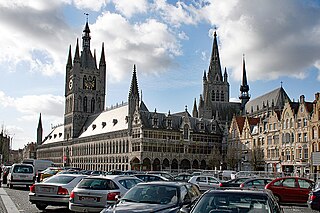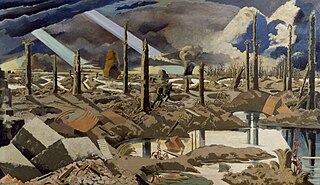
The Third Battle of Ypres, also known as the Battle of Passchendaele, was a campaign of the First World War, fought by the Allies against the German Empire. The battle took place on the Western Front, from July to November 1917, for control of the ridges south and east of the Belgian city of Ypres in West Flanders, as part of a strategy decided by the Allies at conferences in November 1916 and May 1917. Passchendaele lies on the last ridge east of Ypres, 5 mi (8 km) from Roulers, a junction of the Bruges-(Brugge)-to-Kortrijk railway. The station at Roulers was on the main supply route of the German 4th Army. Once Passchendaele Ridge had been captured, the Allied advance was to continue to a line from Thourout to Couckelaere (Koekelare).

Field Marshal Douglas Haig, 1st Earl Haig, was a senior officer of the British Army. During the First World War he commanded the British Expeditionary Force (BEF) on the Western Front from late 1915 until the end of the war.

Ypres is a Belgian city and municipality in the province of West Flanders. Though the Dutch name Ieper is the official one, the city's French name Ypres is most commonly used in English. The municipality comprises the city of Ypres/Ieper and the villages of Boezinge, Brielen, Dikkebus, Elverdinge, Hollebeke, Sint-Jan, Vlamertinge, Voormezele, Zillebeke, and Zuidschote. Together, they are home to about 34,900 inhabitants.

The First Battle of Ypres was a battle of the First World War, fought on the Western Front around Ypres, in West Flanders, Belgium. The battle was part of the First Battle of Flanders, in which German, French, Belgian armies and the British Expeditionary Force (BEF) fought from Arras in France to Nieuwpoort (Nieuport) on the Belgian coast, from 10 October to mid-November. The battles at Ypres began at the end of the Race to the Sea, reciprocal attempts by the German and Franco-British armies to advance past the northern flank of their opponents. North of Ypres, the fighting continued in the Battle of the Yser (16–31 October), between the German 4th Army, the Belgian army and French marines.

Field Marshal Sir William Robert Robertson, 1st Baronet, was a British Army officer who served as Chief of the Imperial General Staff (CIGS) – the professional head of the British Army – from 1916 to 1918 during the First World War.

Field Marshal Herbert Charles Onslow Plumer, 1st Viscount Plumer, was a senior British Army officer of the First World War. After commanding V Corps at the Second Battle of Ypres in April 1915, he took command of the Second Army in May 1915 and in June 1917 won an overwhelming victory over the German Army at the Battle of Messines, which started with the simultaneous explosion of a series of mines placed by the Royal Engineers' tunnelling companies beneath German lines, which created 19 large craters and was described as the loudest explosion in human history. He later served as Commander-in-Chief of the British Army of the Rhine and then as Governor of Malta before becoming High Commissioner of the British Mandate for Palestine in 1925 and retiring in 1928.

Robert Georges Nivelle was a French artillery general officer who served in the Boxer Rebellion and the First World War. In May 1916, he succeeded Philippe Pétain as commander of the French Second Army in the Battle of Verdun, leading counter-offensives that rolled back the German forces in late 1916. During these actions he and General Charles Mangin were accused of wasting French lives. He gives his name to the Nivelle Offensive.
The Ypres Salient, around Ypres, in Belgium, was the scene of several battles and a major part of the Western Front during World War I.

The Battle of Messines was an attack by the British Second Army, on the Western Front, near the village of Messines in West Flanders, Belgium, during the First World War. The Nivelle Offensive in April and May had failed to achieve its more grandiose aims, had led to the demoralisation of French troops and confounded the Anglo-French strategy for 1917. The attack forced the Germans to move reserves to Flanders from the Arras and Aisne fronts, relieving pressure on the French.

Major-General Sir Frederick Barton Maurice, was a British Army officer, military correspondent, writer and academic. During the First World War he was forced to retire from the army in May 1918 after writing a letter to The Times criticizing Prime Minister David Lloyd George for making misleading statements about the strength of British forces on the Western Front. He also later founded the British Legion in 1920, and served as its president from 1932 to 1947.

Field Marshal Douglas Haig, 1st Earl Haig led the British Expeditionary Force during World War I. His reputation is still controversial. Although a popular commander during the immediate post-war years, with his funeral becoming a day of national mourning, Haig also became an object of criticism for his leadership on the Western Front. He was criticised by politicians such as Winston Churchill and David Lloyd George, and by influential historians such as Basil Liddell Hart. Some regard him as representing the very concept of class-based incompetent commanders, stating that he was unable to grasp modern tactics and technologies, and criticism of Haig is sometimes hard to disentangle from criticisms of the war itself. However, many veterans praised Haig's leadership and since the 1980s some historians have argued that the public hatred in which Haig's name had come to be held failed to recognise the adoption of new tactics and technologies by forces under his command, or the important role played by the British forces in the Allied victory of 1918, and that the high casualties suffered were a function of the tactical and strategic realities of the time.

The Menin Road is a large oil painting by Paul Nash completed in 1919 that depicts a First World War battlefield. Nash was commissioned by the British War Memorials Committee to paint a battlefield scene for the proposed national Hall of Remembrance. The painting is considered one of the most iconic images of the First World War and is held by the Imperial War Museum.
Sint-Elooi is a small village, about 5 km (3.1 mi) south of Ypres in the Flemish province of West Flanders in Belgium. The former municipality is now part of Ypres. Though Sint-Elooi is the Dutch and only official name, the village's French name, St. Eloi, is most commonly used in English due to its role in World War I. The village and the nearby locations of Voormezele and Hollebeke were merged into Zillebeke in 1970 and into Ypres in 1976.

In World War I, the area around Hooge on Bellewaerde Ridge, about 2.5 mi (4 km) east of Ypres in Flanders in Belgium, was one of the easternmost sectors of the Ypres Salient and was the site of much fighting between German and Allied forces.

The Calais Conference was a 26 February 1917 meeting of politicians and generals from France and the United Kingdom. Ostensibly about railway logistics for the upcoming allied Spring offensive the majority of the conference was given over to a plan to bring British forces under overall French command. The British Prime Minister David Lloyd George was supportive of the proposal and arranged for the British war cabinet to approve it in advance of the conference, without the knowledge of senior British generals Douglas Haig and Sir William Robertson. The latter were surprised when the proposal was presented by French General Robert Nivelle at the conference. The next day the two generals met with Lloyd George and threatened their resignations rather than implement the proposal. This led to the significant watering-down of the plan with greater freedom given to British commanders. The conference caused mistrust between the British civil and military chiefs and set back the cause of a unified allied command until Spring 1918, when the successful German spring offensive rendered it essential.

The Gheluvelt Plateau actions, July–August 1917 took place from 31 July to 27 August, during the Third Battle of Ypres in Belgium, in the First World War. The British Fifth Army and the German 4th Army fought for possession of the plateau at the highest part of the ridges to the south-east, east and north-east of Ypres in West Flanders. The 4th Army had been building defensive positions in the Ypres Salient since 1915 and the Gheluvelt Plateau was the most fortified section of the front. The Fifth Army had made the plateau its main objective during the Battle of Pilckem Ridge but the II Corps advance was contained short of its objectives and German counter-attacks later recaptured some ground.

114th Siege Battery, was a heavy howitzer unit of the Royal Garrison Artillery (RGA) formed in Wales during World War I. It saw active service on the Western Front at the Somme, Vimy Ridge and Ypres, against the German spring offensive, and in the final Hundred Days Offensive.

174th Siege Battery was a unit of Britain's Royal Garrison Artillery (RGA) formed during World War I. It served on the Western Front, including the Battles of Arras, Messines and Passchendaele, and the crushing victories of the Allied Hundred Days Offensive in 1918.
Leon Wolff was an American historian who wrote In Flanders Fields: The 1917 Campaign.














